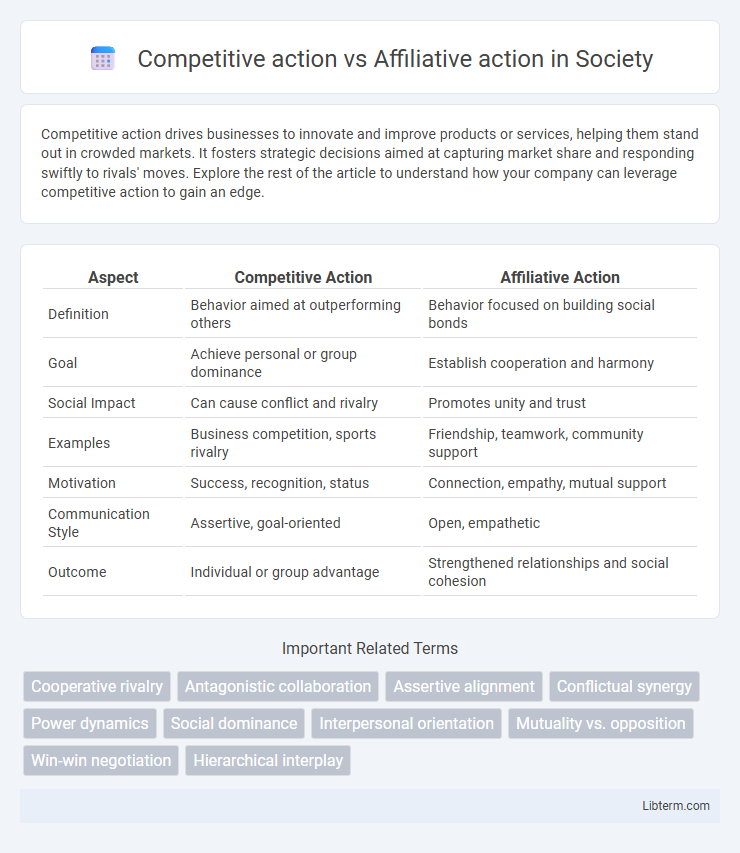Competitive action drives businesses to innovate and improve products or services, helping them stand out in crowded markets. It fosters strategic decisions aimed at capturing market share and responding swiftly to rivals' moves. Explore the rest of the article to understand how your company can leverage competitive action to gain an edge.
Table of Comparison
| Aspect | Competitive Action | Affiliative Action |
|---|---|---|
| Definition | Behavior aimed at outperforming others | Behavior focused on building social bonds |
| Goal | Achieve personal or group dominance | Establish cooperation and harmony |
| Social Impact | Can cause conflict and rivalry | Promotes unity and trust |
| Examples | Business competition, sports rivalry | Friendship, teamwork, community support |
| Motivation | Success, recognition, status | Connection, empathy, mutual support |
| Communication Style | Assertive, goal-oriented | Open, empathetic |
| Outcome | Individual or group advantage | Strengthened relationships and social cohesion |
Understanding Competitive Action: Definition and Key Traits
Competitive action involves behaviors aimed at outperforming others, often driven by a desire for dominance, achievement, or superiority in social or professional contexts. Key traits include assertiveness, goal orientation, strategic thinking, and a high tolerance for risk and conflict. This type of action prioritizes self-interest and measurable success, distinguishing it from affiliative action, which emphasizes cooperation and relationship-building.
What Constitutes Affiliative Action? Core Principles
Affiliative action constitutes behaviors and strategies aimed at fostering positive social connections, collaboration, and mutual support within groups or communities. Core principles include empathy, active listening, trust-building, and cooperation, which prioritize maintaining harmony and strengthening interpersonal relationships over individual gain. These actions emphasize shared goals and collective well-being, contrasting with competitive actions that focus on rivalry and winning.
Competitive vs Affiliative: Psychological Foundations
Competitive action arises from the psychological need for achievement and dominance, driven by self-enhancement and social comparison processes. Affiliative action stems from the intrinsic motivation for social bonding, cooperation, and belongingness, grounded in attachment theory and the need for interpersonal connection. Neurobiological research links competitive behavior with heightened activity in reward-related brain regions such as the striatum, while affiliative behavior engages the oxytocinergic system, promoting empathy and prosocial conduct.
Real-life Examples: Competitive and Affiliative Actions
Competitive actions, such as athletes racing in the Olympics or companies launching rival products, drive individuals or groups to outperform others, fueled by the desire for dominance and achievement. Affiliative actions manifest in community volunteer efforts or team-building activities in workplaces, fostering cooperation, social bonding, and mutual support. Real-life examples highlight how competitive actions prioritize success and individual goals, while affiliative actions emphasize relationships and collective well-being.
Impacts on Team Dynamics and Performance
Competitive action often drives individual achievement but can foster rivalry and reduce cohesion within teams, potentially undermining collaborative problem-solving and overall performance. Affiliative action promotes trust, open communication, and emotional support, which enhances team cohesion, cooperation, and collective resilience under pressure. Teams balancing competitive drive with affiliative bonds achieve higher performance by leveraging motivation alongside strong interpersonal relationships.
Advantages and Drawbacks of Competitive Action
Competitive action drives innovation and market differentiation by pushing organizations to outperform rivals through aggressive strategies such as pricing, product development, and marketing campaigns. Its advantages include increased efficiency, higher market share, and the ability to capture untapped customer segments. Drawbacks involve potential burnout among employees, increased conflict, and the risk of short-term focus overshadowing long-term strategic goals.
Affiliative Action: Benefits and Potential Limitations
Affiliative action fosters collaboration and strengthens social bonds by promoting inclusivity and cooperative behavior, which can lead to enhanced team cohesion and increased trust among group members. This approach encourages mutual support and positive interpersonal relationships, making it particularly effective in environments that require collective problem-solving and emotional intelligence. However, affiliative action may sometimes result in groupthink or reduced decisiveness when prioritizing harmony over critical evaluation or competitive drive.
Choosing the Right Approach: Context Matters
Competitive action drives individuals to prioritize personal goals and assert dominance, which is effective in high-stakes environments like negotiations or sports where clear winners are needed. Affiliative action fosters collaboration and relationship-building, essential in team settings, conflict resolution, and organizational culture development to enhance trust and communication. Selecting the right approach depends heavily on situational context, task urgency, group dynamics, and desired outcomes, balancing assertiveness with empathy for optimal results.
Integrating Competitive and Affiliative Strategies
Integrating competitive and affiliative strategies enhances organizational effectiveness by balancing goal-oriented drive with relationship-building. Competitive actions emphasize assertiveness and achievement to secure advantages, while affiliative actions foster collaboration and emotional bonds that support teamwork. The strategic combination enables conflict resolution, promotes innovation, and sustains a cohesive environment crucial for long-term success.
Future Trends in Competitive and Affiliative Behaviors
Emerging research indicates that future trends in competitive actions will increasingly integrate technology-driven strategies such as AI analytics and real-time data to optimize decision-making and resource allocation. Affiliative behaviors are projected to emphasize digital collaboration platforms and virtual communities, enhancing social bonding and cooperative problem-solving across global networks. Both competitive and affiliative actions are expected to evolve with a focus on sustainability and ethical considerations, reshaping organizational dynamics and interpersonal interactions.
Competitive action Infographic

 libterm.com
libterm.com